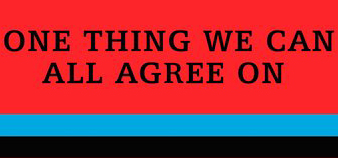


One thing the Invisible Children did incredibly well was their use of design and semiotics. Their main poster uses its design features to actively engage people ranging in both parts of the political parties of the US. On a basic level, the prime color scheme of this poster consists of red, white, blue, and black. On the dennotive level, these colors are just colors, but using Roland Barthes term of connotation, the combination of the three creates the connotation of patriotism and liberty, automatically commanding the attention of any US citizen, as they are the colors found on our country's flag (Rose). The black against the background of the bright colors does two things. First it highlights the important linguistic information found on the poster. In this specific case, the black also introduces a negative connotation of something bad; Joseph Kony.
| The next level of semiotics I would like to approach comes from the actual graphics found on the poster. To the left, we can see an elephant. To the right, we can see a donkey. In the middle there is a single white dove, with an olive branch in its mouth. Both the donkey and the elephant are split into two sections. One half is covered in black, while the other half, split by a red stripe, is covered in blue with three white stars. These two images fuse together to create the shape of the dove, which is white and stands out in comparison. With the primary level of significance, we can see that these animals are all symbols that are interacting, but things begin to get interesting when we reveal the connotations of the animals. |  |

These specific animals have certain connotations and connections with certain political parties in the United States. The elephant is a well-known symbol of the Republican Party. The donkey is a well-known symbol of the Democratic Party. The white dove that comes from the fusion of the two is clearly a symbol of peace. These signs out of context mean nothing but what they are literally representing, but using Ferdinand de Saussere's concept of the signified, we can push past the primary round of meaning into the the concepts behind the animals (Rose). This combination of the donkey, a symbol of the Democratic Party, and the elephant, a symbol of the Republican Party, in order to create the white dove, a color often associated with peace and serenity operates on Barthes' notion of myth (Rose). This myth assumes that everyone seeing the propaganda with this image belongs to one of these two parties, and that KONY 2012 should be the one thing that brings these two parties together in order to create a peaceful, unified front. Also, with the combination of patriotic colors, and the three white stars, the political symbols also support the intentional patriotism found in this propaganda. |
|
| The final level of semiotic analysis comes from the linguistics aspect. The anchorage of the concept of this poster comes together from the text, which supports the claims made in the graphics steering the reader clear of any polysemic meanings that could be found in the strong use of symbols. The main, largest statement that comes from the poster is "KONY 2012", which has been divided by the graphics of the elephant, the dove, and the donkey. This large typeface on the background of the red is immediately eye catching and demands the attention of people looking upon the poster. Below this eye-catching text, a single statement reads: "One thing we can all agree on." This statement acts to support the graphic and the myth binary that the graphic operates on. While the graphic visually creates the concept of "togetherness" and "unity" of the country over one issue, the linguistic message visually confirms this, anchoring the reader in the correct meaning of the poster, just in case the viewers didn't quite get the message. | 
|